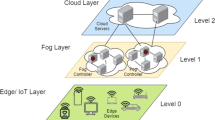Abstract
Adaptive streaming has recently emerged as a technology enabling high-quality streaming at various bitrates. One of the video streaming challenges remains in research topic nowadays that is choosing optimal segment base on network characteristics and streaming devices, such as network bandwidth, latency, the computational capacities of devices. Researchers have proposed many algorithms to overcome such issues within their predefined conditions. However, those proposed methods do not perform efficiently in the heterogeneous network today. Consequently, in this article, we present research on a context-aware adaptive algorithm for ambient intelligence dynamic adaptive employing mobile edge computing (MEC). Specifically, we apply deep learning in the adaptive algorithm which is installed at the MEC to assist clients in choosing the optimal streaming segments as well as reduce network latency. Furthermore, we apply the multilayer perceptron classifier with data obtained from various experiments of adaptive streaming algorithms then combine them in a general algorithm. In the analysis, we use network simulator NS3 as a tool to carry out the verification of our proposed method. As a result, the proposed research reduces network latency as well as improve quality streaming compared to existing approaches.










Similar content being viewed by others
References
Chauhan R, Kaur H, Chang V (2017) Advancement and applicability of classifiers for variant exponential model to optimize the accuracy for deep learning. J Ambient Intell Humaniz Comput. https://doi.org/10.1007/s12652-017-0561-x
Feng J, Xuefen C, Li P, Yining W, Guan L, Wang X (2010) Adaptive FEC algorithm based on prediction of video quality and bandwidth utilization ratio. J Ambient Intell Humaniz Comput 1:309–318
Huang R, Feng W, Fan M, Guo Q, Sun J (2017) Learning multi-path CNN for mural deterioration detection. J Ambient Intell Humaniz Comput. https://doi.org/10.1007/s12652-017-0656-4
Kim E, Kim J, Lee C (2018) Efficient neighbor selection through connection switching for P2P live streaming. J Ambient Intel Humaniz Comput. https://doi.org/10.1007/s12652-018-0691-9
Lee I, Guan L (2012) Inter-frame dependency in multiview multi-description video streaming. J Ambient Intell Humaniz Comput 3:87–94
Liu C, Bouazizi I, Gabbouj M (2011) Rate adaptation for adaptive HTTP streaming. In: Proceedings of the second annual ACM conference on multimedia systems (2011) ACM, pp 169–174
Liu C, Bouazizi I, Hannuksela MM, Gabbouj M (2012) Rate adaptation for dynamic adaptive streaming over HTTP in content distribution network signal processing. Image Commun 27:288–311
Ma LV, Park J, Nam J, Ryu H, Kim J (2017) A fuzzy-based adaptive streaming algorithm for reducing entropy rate of DASH bitrate fluctuation to improve mobile. Qual Serv Entropy 19:477
Miller K, Quacchio E, Gennari G, Wolisz A (2012) Adaptation algorithm for adaptive streaming over HTTP. In: Packet video workshop (PV), 2012 19th international (2012) IEEE, pp 173–178
Mok RK, Luo X, Chan EW, Chang RK (2012) QDASH: a QoE-aware DASH system. In: Proceedings of the 3rd multimedia systems conference (2012) ACM, pp 11–22
Orsini G, Bade D, Lamersdorf W (2018) Generic context adaptation for mobile cloud computing environments. J Ambient Intell Humaniz Comput 9:61–71
Roman R, Lopez J, Mambo M (2018) Mobile edge computing. fog et al.: a survey analysis of security threats challenges Future Gen Comput Syst 78:680–698
Tang J, Deng C, Huang G-B (2016) Extreme learning machine for multilayer perceptron. IEEE Trans Neural Netw Learn Syst 27:809–821
Tian G, Liu Y (2012) Towards agile and smooth video adaptation in dynamic HTTP streaming. In: Proceedings of the 8th international conference on emerging networking experiments and technologies (2012) ACM, pp 109–120
Van Ma L, Kim J, Park S, Kim J, Jang J (2016) An efficient Session_Weight load balancing and scheduling methodology for high-quality telehealth care service based on WebRTC. J Supercomput 72:3909–3926
Van Ma L, Park J, Nam J, Jang J, Kim J (2017) An efficient scheduling multimedia transcoding method for DASH streaming in cloud environment. Cluster Comput, pp 1–11
Vergados DJ, Michalas A, Sgora A, Vergados DD (2014a) A control-based algorithm for rate adaption in MPEG-DASH. In: Information, intelligence, systems and applications, IISA 2014, The 5th international conference on (2014) IEEE, pp 438–442
Vergados DJ, Michalas A, Sgora A, Vergados DD (2014b) A fuzzy controller for rate adaptation in MPEG-DASH clients. In: Personal, indoor, and mobile radio communication (PIMRC), 2014 IEEE 25th annual international symposium on (2014) IEEE, pp 2008–2012
Vergados DJ, Michalas A, Sgora A, Vergados DD, Chatzimisios P (2016) Fdash: a fuzzy-based MPEG/DASH adaptation algorithm. IEEE Syst J 10:859–868
Xu X, Liu J, Tao X (2017) Mobile edge computing enhanced adaptive bitrate video delivery with joint cache and radio resource. Alloc IEEE Access 5:16406–16415
Acknowledgements
This research was supported by the IT R&D program of MSIT(Ministry of Science and ICT), Korea / NIPA(National IT Industry Promotion Agency) 12221-14-1001, Next Generation Network Computing Platform Testbed. Besides, this research was supported by Basic Science Research Program through the National Research Foundation of Korea (NRF) funded by the Ministry of Education, Science, and Technology (MEST)(Grant No. NRF-2017R1D1A1B03034429). Furthermore, this research was supported by the MSIT(Ministry of Science and ICT), Korea, under the ITRC(Information Technology Research Center) support program(IITP-2018-2016-0-00314) supervised by the IITP(Institute for Information & communications Technology Promotion). Lastly, this work was supported by Institute for Information & communications Technology Promotion(IITP) grant funded by the Korea government(MSIT)(R0190-17-2009,Development of endpoint protection technology using white list and context-aware).
Author information
Authors and Affiliations
Corresponding author
Additional information
Publisher’s Note
Springer Nature remains neutral with regard to jurisdictional claims in published maps and institutional affiliations.
Electronic supplementary material
Below is the link to the electronic supplementary material.
Rights and permissions
About this article
Cite this article
Kim, J., Won, Y., Yoon, C. et al. A Context-aware adaptive algorithm for ambient intelligence DASH at mobile edge computing. J Ambient Intell Human Comput 11, 1377–1385 (2020). https://doi.org/10.1007/s12652-018-1049-z
Received:
Accepted:
Published:
Issue Date:
DOI: https://doi.org/10.1007/s12652-018-1049-z




